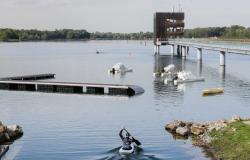Out of 8.36 million voters registered for the federal elections in Belgium, only 7.31 million people cast a ballot in the box intended to elect representatives to the House. More than a million Belgians therefore did not bother to travel to fulfill this obligatory civic duty. The participation rate is even slightly down, at 87.42%, compared to the 88.38% recorded during the previous elections, in 2019. The “abstainers” – whose motivations or causes of impediment can be numerous – therefore represent more than 12% of the electorate.
This rate is even higher for the regional elections to the Walloon Parliament, where the level of participation is at 86.8%, while it reaches up to 93.53% in the Flemish region, an increase. For the European vote, we are at 89.8% participation, also increasing. The lowest participation is measured in the Brussels Region, with only 83.86%.
1.4 million non-voters
If, now, we add to the silence of the abstainers the choice of those who preferred to put a blank ballot in the ballot box, or who made their vote invalid, voluntarily or not, by not respecting the instructions, the party of “ non-voters” still swells considerably. For the elections to the Chamber, again, there were 5.69% of blank or invalid votes, or 416,000 “lost” votes, which are added to the previous million. There are therefore nearly 1.4 million Belgians who do not participate concretely in the designation of elected officials. Or nearly 16.7% of potential voters. The party which obtained the most votes at the federal level, the N-VA, garnered 1.16 million votes, or 16.7% of the valid votes, but 13.8% of those registered.
For the 2024 federal elections, the rate of blank or invalid ballots fell slightly compared to the 6.07% observed five years ago. This is far from being the case for the elections to the Walloon Parliament, where this rate of blank or invalid ballots increased from 8.36% in 2019 to 8.49% this Sunday, June 9. That is 191,923 “unusable” ballots out of 2.26 ballots cast, and 2.6 million registered voters. Brussels and Europe find themselves with more or less the same rate of blank and invalid ballots (6.1%) while, on the Flemish side, we are also at a low level, with a rate of 4.7%, down by compared to 2019.
Blanco does not do better
Note that those who wanted to vote “blank” to express their political discontent could just as well opt for the Blanco list, the idea of which was precisely to recover part of these invalid votes. We will not say that the initiative paid off, since this Blanco list, in the Chamber, only received 75,683 votes (1.08%), ahead of the far-right French-speaking party Chez nous (64,058 votes). , 0.92%). The small “protest” parties, in general, do not perform well in these 2024 elections. For the Walloon Parliament, adding to the 2.83% of Chez nous the 1.6% of the Citizen Collective and the 0.3 % of the RMC, we are less than 100,000 votes away. Half as many as blank or invalid ballots.
In the absence of Blanco in the regional election, blank and invalid votes increased, unlike the federal one.






